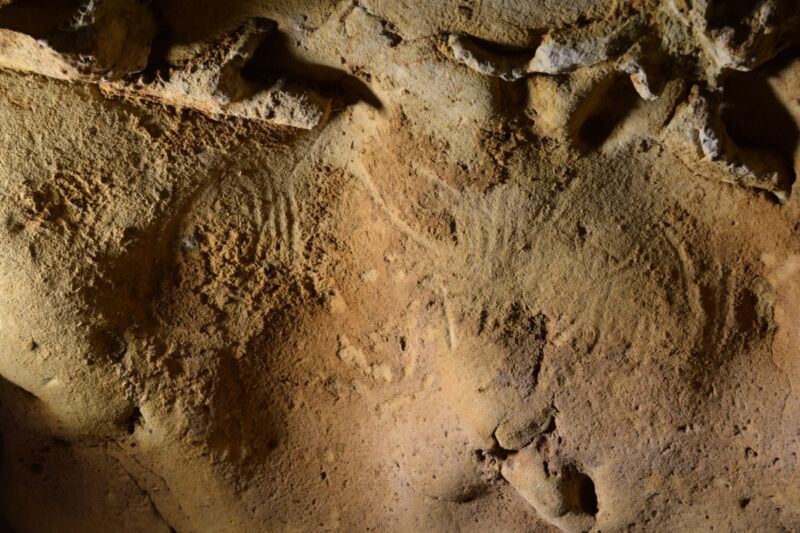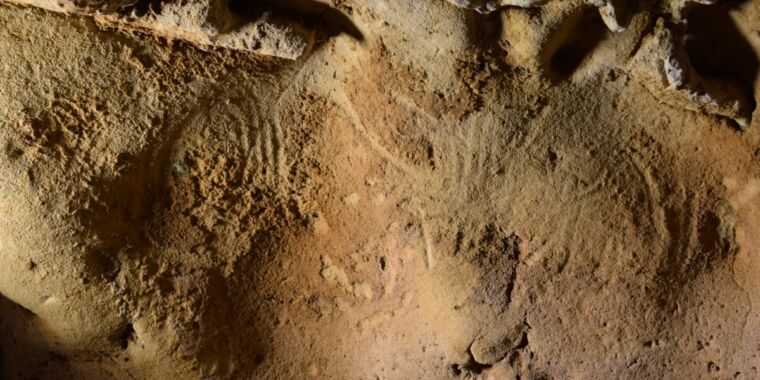
Archaeologists have concluded that a series of engravings discovered on a cave wall in France were made by Neanderthals using their fingers some 57,000 years ago. They could be the oldest traces yet found and further evidence that Neanderthal behavior and activities were much more complex and diverse than previously believed, according to a new paper published in the journal PLoS ONE.
As Kiona Smith previously reported for Ars, in recent years there has been mounting evidence that Neanderthals could think symbolically, create art, and plan a project. About 50,000 years ago, Neanderthals in France spun plant fibers into thread. In central Italy, between 55,000 and 40,000 years ago, Neanderthals used birch tar to hold their stemmed stone tools in place, which required a lot of planning and complex preparation. In 2016, we reported on archaeologists’ announcement that a Neanderthal group had wrestled hundreds of stalagmites from the floor of a cave in Bruniquel Cave in southern France to build intricate circular structures, their work illuminated only by firelight.
Archaeologists have also found several pieces of bone and stone from the Middle Paleolithic – the time when Neanderthals had most of Europe to themselves – carved with geometric patterns such as crosshatches, zigzags, parallel lines and circles. That could mean that the ability to use symbols did not originate in modern humans.
For example, in 2018, archaeologists claimed that uneven lines seen in the soft, chalky outer layer of a small, thin flint flake were an intentional marking. It was found in the Kiik-Koba Cave, which overlooks the Zuya River in the Crimean Mountains. The engraved flake came from a layer that was between 35,486 and 37,026 years old. Archaeologists found the skeleton of a Neanderthal child in the same layer, leaving no doubt as to who lived in Kiik-Koba when the stone tools were made and used.
In 2021, archaeologists announced they had found a geometric design resembling “offset chevrons” carved into the second phalanx, or toe bone, of a giant deer in a cave now called Einhornhohle in the Harz Mountains of northern Germany. The sculptor was almost certainly Neanderthal, based on the bone’s radiocarbon dating, as none other than Neanderthals lived in Europe until about 45,000 years ago.
The authors argued that this was a legitimate project; it took imagination to plan the design and figure out that a few individual lines would lead to a more complex pattern. It took resources and planning to assemble the tools, and it took time and effort to actually cut out the pattern, as well as a good supply of small, sharp flint knives. The researchers could vouch for that, because they tried it themselves, using cow phalanges and hand-knotted blades made from Baltic flint, the stone to which a North German Neanderthal bone cutter most likely would have had access.
Neanderthals in Spain painted the walls of caves about 64,000 years ago and made jewelry from shells painted with ocher pigment. The art analyzed in the caves of La Pasiega, Maltravieso and Ardales is unequivocally Neanderthal. Uranium-thorium dating of rock deposited in paintings in all three caves indicates that the paintings cannot be less than 64,000 years old. Unlike the first homo sapiens, which emerged only 20,000 years after the rock of the caves began to flow over the art, Neanderthals were already living in the region at least 243,000 years ago.
And in a sea cave called Cueva de los Aviones, on Spain’s southeastern coast, archaeologists found shells decorated with red and yellow pigment with holes punched into them as if they were string. It is generally believed to be jewelry, which is a different kind of symbol. Here too, running water had deposited a liquid stone over the layer of sediment in which these shells were found. Uranium thorium dating said the flowstone couldn’t be younger than 114,000 years. In fact, they predate any comparable set of artifacts found to date by at least 20,000 to 40,000 years.

